While people with diabetes can safely get tattoos, there are important considerations to keep in mind before heading to a tattoo parlor.
This article covers what you need to know about diabetes and tattoos, the potential risks, and how to ensure proper healing.
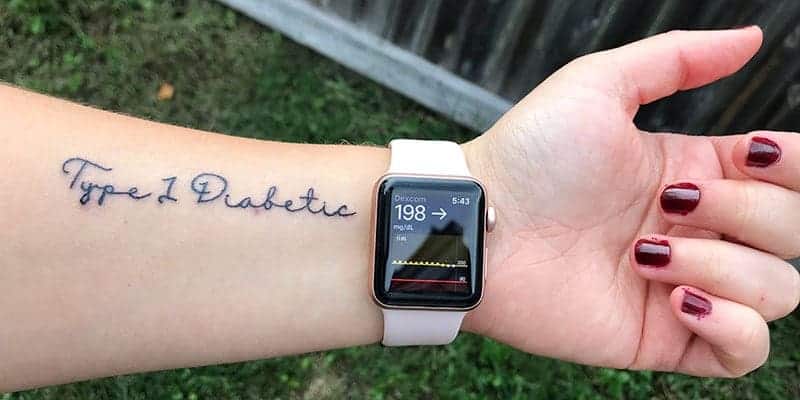
Key Points:
- People with diabetes can safely get tattoos, but it’s important to carefully manage blood glucose (sugar).
- Tattoos on areas with impaired circulation or common injection sites should be avoided due to slower healing.
- Proper aftercare, including keeping the tattoo clean and moisturized, is necessary to prevent infections.
- Medical alert tattoos may not be fully recognized by EMTs and should not replace traditional medical alert jewelry.
Table of Contents
- Your A1c and overall risk of infection in a new tattoo
- What the healthy healing process of a tattoo should look like
- How to properly care for your new tattoo
- The most common causes of infections in tattoos
- Consider the location of your tattoo
- When it’s time to get your first tattoo…
- Do EMTs notice “medical alert” diabetes tattoos?
- Is a tattoo the right choice for you?
- Diabetes tattoo ideas
Your A1c and overall risk of infection in a new tattoo
People with diabetes are often discouraged from getting tattoos because higher blood sugar levels impair healing and increase the risk of infection.
According to research in Diabetes Care, both type 1 and type 2 diabetes increase infection risks, with type 1 posing a slightly higher threat.
Similar to how untreated blisters can lead to infections and gangrene, tattoos on people with poorly managed blood sugar can become seriously infected.
Consider the following guidelines for A1c (a measure of glucose management over the previous 2 to 3 months) before getting a tattoo:
A1c under 8.0: If your last few A1c tests were below 8 percent, and you don’t have complications like neuropathy (nerve damage), heart disease, or kidney issues, a tattoo should be safe if you take care of the tattoo and manage your blood sugar well.
A1c over 9.0: If your A1c is 9 percent or higher, or if you have complications like neuropathy or circulation issues, getting a tattoo can be dangerous. Slow healing can create a breeding ground for bacteria, potentially leading to infection or gangrene.
Having a high A1c doesn’t mean you can never get a tattoo; it may be motivation to improve your blood sugar management first.
Leanne Matthews, who has lived with type 1 diabetes for over 16 years and has three tattoos, notes,
“I wasn’t concerned because my blood sugars are tightly controlled, and my A1c is under 7.”
She advises waiting until blood sugars are in a healthy range to avoid complications.
Read more in: How to Lower Your A1c: The Complete Guide.
Is metformin an issue?
For those taking metformin to manage type 2 diabetes, there’s no direct concern about the medication affecting your ability to get a tattoo.
The most important factor is keeping your blood sugars in a healthy range to minimize infection risks and ensure proper healing.
What the healthy healing process of a tattoo should look like
No one’s tattoo looks great during the first week of healing, so it’s helpful to know what’s normal. Authority Tattoo explains the stages of healing:
- Stage one (Days 1-6): Oozing, swelling, and redness are common but should gradually improve each day. Scabbing will begin to form.
- Stage two (Days 7-14): Itching and flaking start, and this continues until all dead skin and scabs have fallen off.
- Stage three (Days 15-30): The tattoo may look fully healed but could appear slightly cloudy. Deeper layers of skin are still repairing, so keep caring for it.
How to properly care for your new tattoo
Caring for your new tattoo is straightforward but important to prevent infection and ensure it looks great once healed. Your tattoo artist will provide instructions, but here are the basics:
- Gently wash your tattoo every morning and night with lukewarm water and antibacterial soap. Pat it dry with a clean towel or paper towel.
- Rinse it anytime it comes into contact with dirt, sweat, or other unclean environments.
- Apply a recommended lotion, such as Vaseline or cocoa butter, twice a day. Avoid lotions with added scents or colors, as these can increase the risk of infection.
Leanne, who has multiple tattoos, said,
“Every tattoo artist gives different aftercare advice, but the main point is always to keep it clean.”
As a regular gym-goer, she made sure to wash her tattoos right after each workout to avoid infection from sweat and gym equipment.
“With my largest tattoo on my thigh, I paid extra attention to cleanliness because it’s a bigger area that could easily get infected.”
The most common causes of infections in tattoos
Preventing an infection while your new tattoo heals sounds simple — just keep it clean, right?
But there’s actually a long list of things that can easily introduce infection, many of which you might not even consider, like the type of lotion you use daily.
Here are the most common causes of tattoo infections:
- High blood sugar levels in people with diabetes
- Unsanitary tattooing environment or equipment
- Ineffective cleaning practices
- Rewrapping the tattoo (traps germs and sweat)
- Picking or peeling scabs (scabs help skin heal!)
- Scratching your tattoo
- Bathing in dirty water (opt for showers)
- Letting others touch your new tattoo
- Using too much lotion — apply only as directed
- Unhealthy lifestyle habits around nutrition, alcohol, sleep, etc.
Keep your tattoo clean and dry, don’t scratch or pick at it, and stick to the recommended tattoo moisturizer like Vaseline. And when showing it off, remind friends to look but not touch!
Signs of an infection in a new tattoo
“Right after getting a new tattoo, the area is essentially a large, open wound, highly vulnerable to germs and bacteria until scabs form and a protective outer skin layer develops,”
explains Authority Tattoo.
They also warn that even small tattoos can become seriously infected and require prompt attention.
“If left untreated, some infections can lead to blood poisoning, shock, and eventually organ failure or death.”
Here are the most common signs of infection:
- Spotty rash (red or white)
- Extreme redness 5 days after getting the tattoo
- Intense itching (mild itching with healthy scabs is normal; apply more Vaseline)
- Hot to the touch
- Swelling 5 days after the tattoo
- Oozing scabs (normal scabbing is fine; oozing is not)
- Blistering
- Excessive pus, especially with pimple-like bumps
- Foul odor
- Red streaking around the tattoo (a sign of blood poisoning)
- Swollen lymph nodes (indicates your body is fighting infection)
- Fever and tiredness
If you notice any of these symptoms, visit your doctor or urgent care right away. People with diabetes need to take infections very seriously, even with well-managed A1c levels, because our bodies are more susceptible to complications.
To view pictures of infection symptoms, check out Authority Tattoo — but be warned, the images are graphic!
Consider the location of your tattoo
As if diabetes doesn’t already intrude on enough parts of your life, it even gets to dictate where you can safely get a tattoo.
Areas with impaired circulation
Even if your A1c has been under 8 percent for years, certain areas of your body still have impaired circulation.
Your hands, feet, ankles, and shins are common “tattooable” spots but may not heal as quickly due to poor blood flow, putting you at higher risk for infection.
If you have neuropathy and still choose to get a tattoo, it’s best to avoid these areas altogether.
Common injection, infusion, and CGM sites
Do you frequently inject insulin in the back of your arm? Is your pump infusion site usually on your abdomen or thigh? These areas tend to develop scar tissue over time, making them less ideal for tattoos.
Plus, once you tattoo an area, you won’t want to continue using it for injections or sensors, as repeated needle use can damage your tattoo.
Leanne admits she didn’t follow this advice too closely.
“I picked the spot where I wanted it. I’m not gonna let diabetes tell me where I can get a tattoo. If I want it on my thigh, that’s where it’s going, and I’ll just stop using that spot for injections.”
While it’s frustrating that diabetes gets to weigh in on where you get a tattoo, it’s crucial to think carefully before choosing a spot that might interfere with injections or healing!
When it’s time to get your first tattoo…
If there’s ever a time to get a little obsessive about your blood sugar management, it’s right before you get a tattoo and during the weeks afterward as it heals.
Remember, even if your tattoo appears healed on the outside after the first week, plenty of healing still takes place in the tissue below the surface.
The more consistently you keep your blood sugars in a healthy range during the healing process, the better and faster it will heal, reducing your chances of complications or infection.
Do EMTs notice “medical alert” diabetes tattoos?
It’s common to see “type 1 diabetes medical alert” tattoos on social media, but before replacing your medic alert jewelry with a tattoo, it’s important to know whether EMTs and ER professionals actually look for them.
The truth is, EMTs won’t necessarily notice or rely on a tattoo. Leanne says,
“A friend of mine is an EMT. She mentioned they can’t assume someone has diabetes just because of a tattoo — it could represent their child’s diabetes.”
That said, EMTs may still spot the tattoo and decide to check your blood sugar, leading to the right diagnosis. While not entirely overlooked, a tattoo shouldn’t replace traditional medical alert jewelry.
Is a tattoo the right choice for you?
Getting a tattoo is a big decision — and for some people, it could even be life-threatening. While none of us want diabetes to dictate what we can or can’t do, it’s important to be honest about your blood sugar management before committing to a tattoo.
If the idea of getting inked motivates you to improve your blood sugar management, that’s fantastic!
In the meantime, you could always grab a Sharpie and practice drawing it on until you’re ready. (And seriously, think twice about the design — a picture of Ryan Gosling’s face on your left butt cheek might not seem as cute when you’re 65!)
Diabetes tattoo ideas
We asked our Facebook community to share their diabetes tattoos, and more than 100 people responded with their ink. Here are just a few of the tattoos they shared:
“I am more than my highs and lows” diabetes tattoo
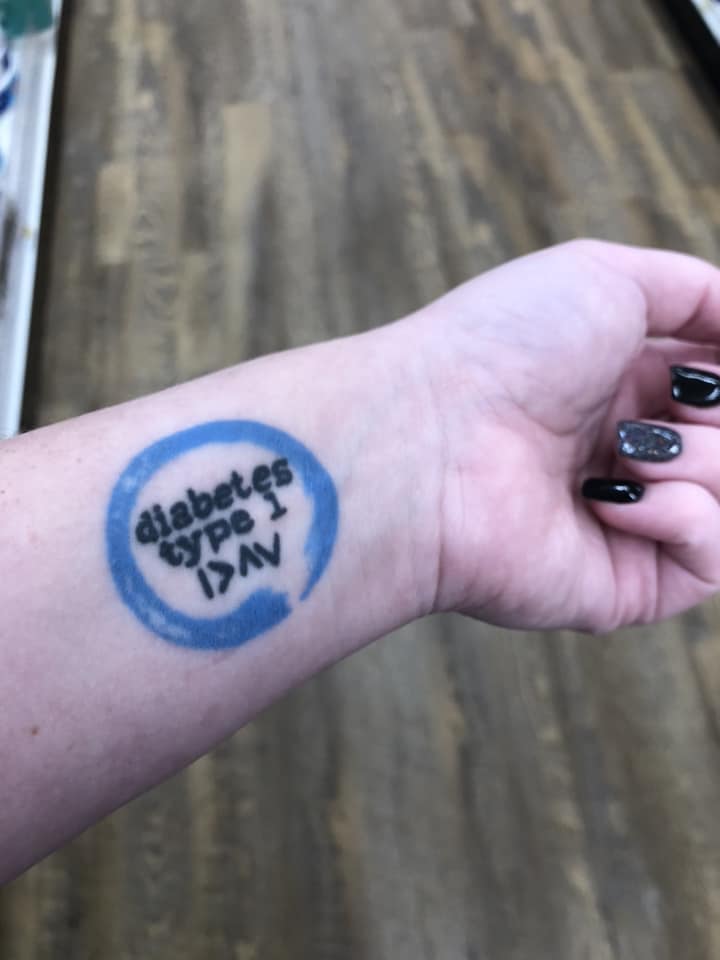
Medical alert diabetes tattoo
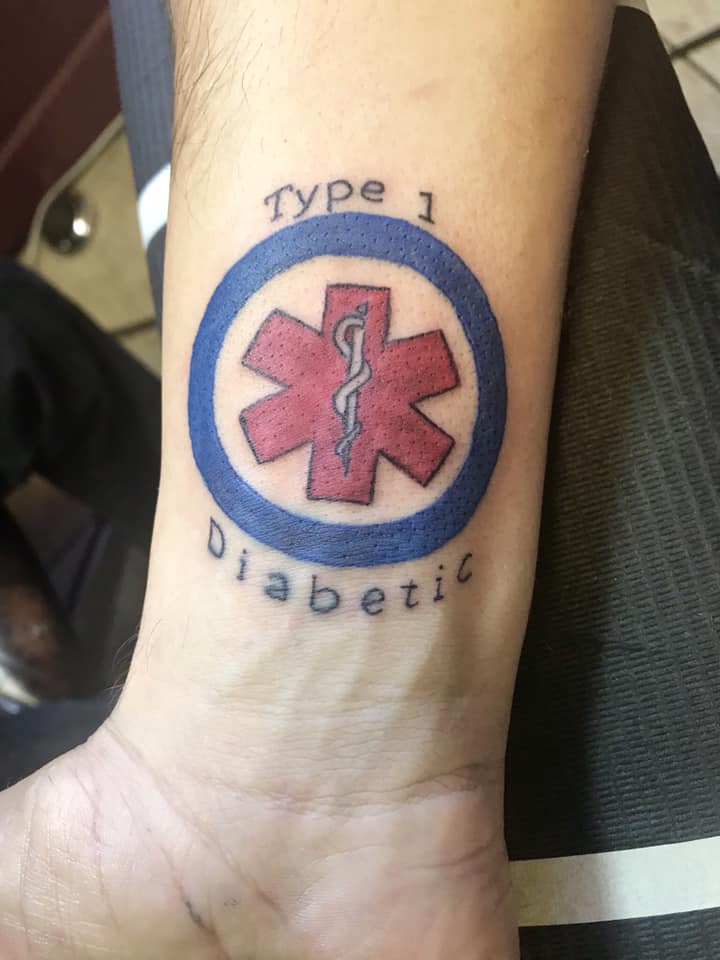
Type 1 diabetes tattoo
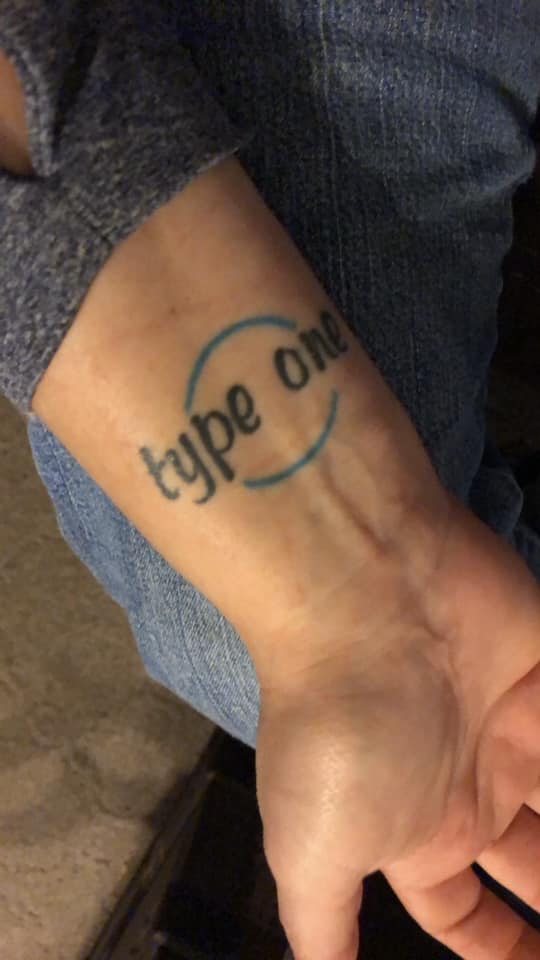
Insulin-dependent tattoo
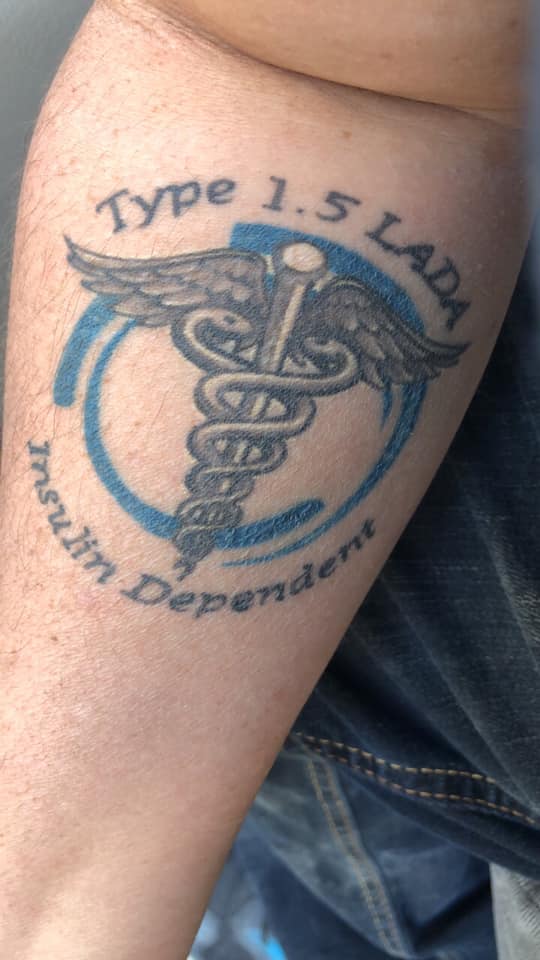
Artistic diabetes tattoo
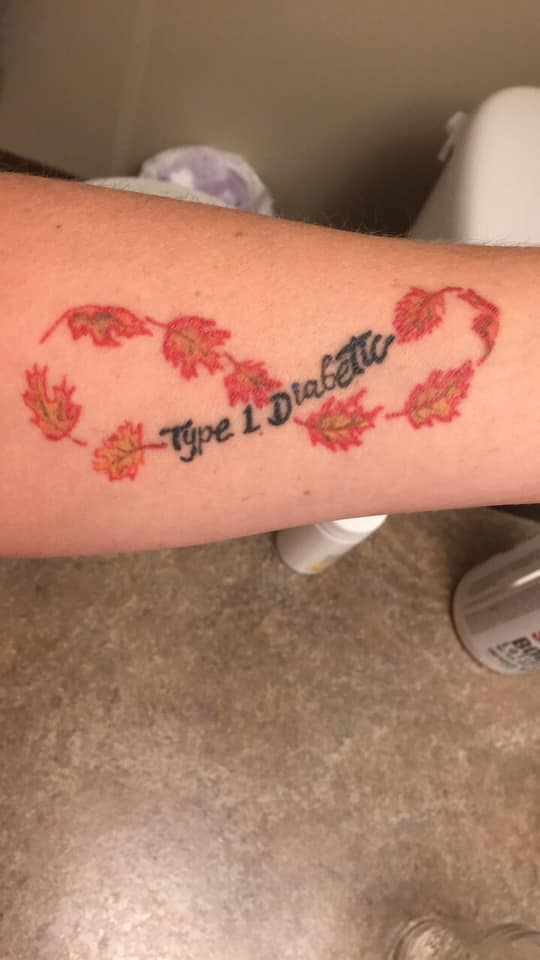
T1 Diabetic tattoo
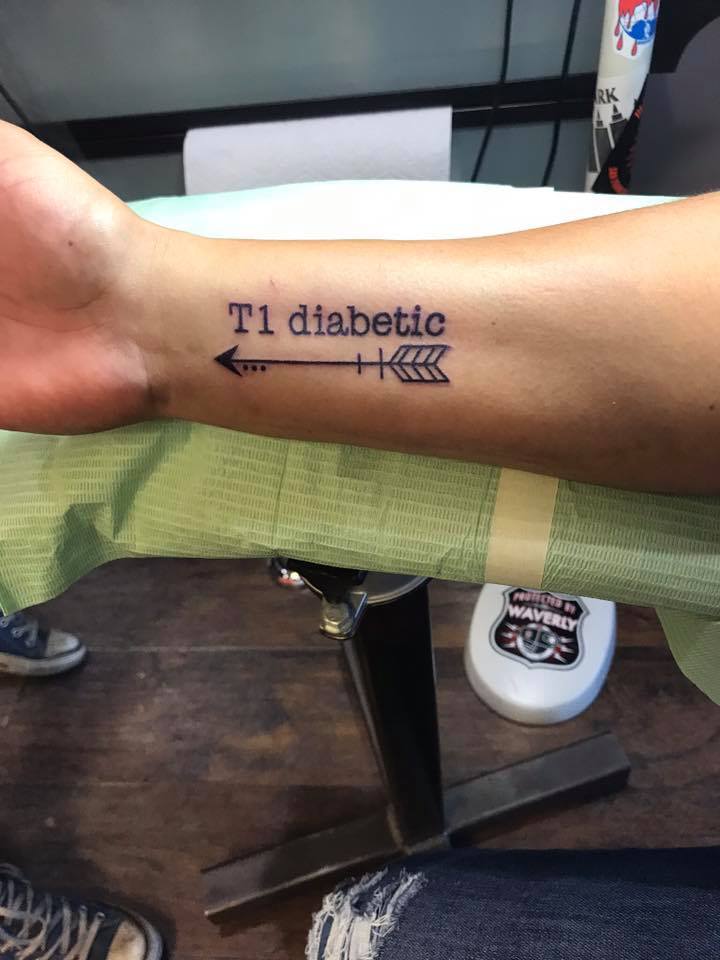
Blue circle diabetes tattoo
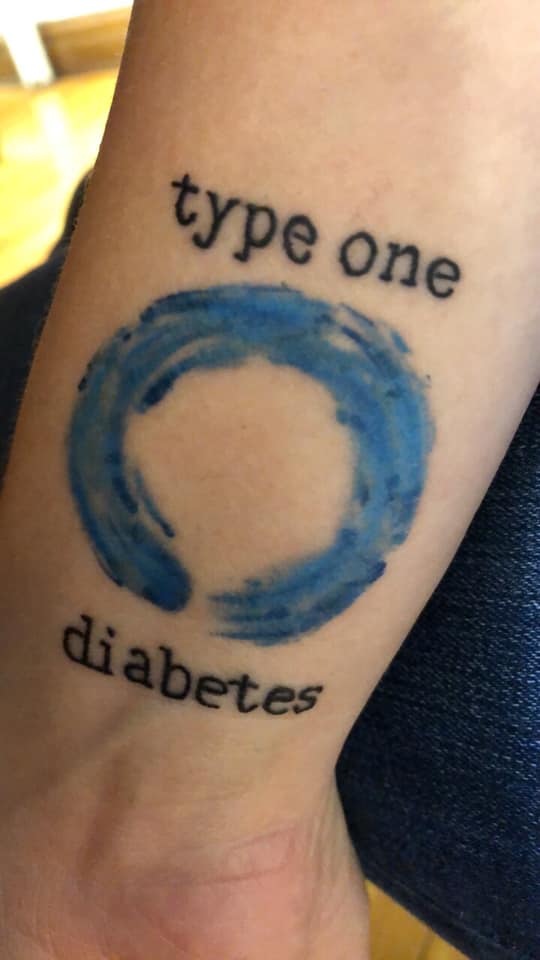
Did you find this article helpful? Click Yes or No below to let us know!

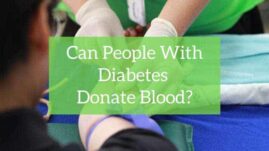

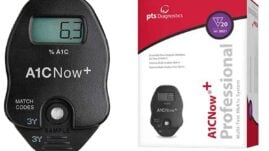

Stewart Gale
If you’re reading this, please don’t apply Vaseline or cocoa butter to a new tattoo!! Stick to non-fragrant, non-oil based, such as organic virgin coconut oil (lotion). Moisturise well but allow it to be thin enough f it e the skin to breathe! Good luck!!
Yael
I (Type 1, HgA1C below 7) have alrwady tattoed eyebrows (6 times) and eyes (3 times). Never had any complications and I am very happy with the results. It is safer and less painful then microblading.
Libby Bustos
Hi. I really want eyeliner tattoos. It scares me but the trouble I have putting makeup on wrinkled eyes when you can’t even see well enough with a 20x mirror is so frustrating. I can’t wear contacts anymore so I want to have eyeliner tattooed. My last A1C was below 6.
Tammy M Marsh
Hi- DO IT! I had my eyeliner tabooed and am so glad I did it. Follow post instructions and do it when it is cold out so you you can keep it out of direct sunlight more.
steven mcdermott
Hi please can anyone advise what the best ink for a diabetic as the last tattoo I had I had a reaction to the ink but need it finishing so please help me thanks
Christel Oerum
That I can’t help with, but hopefully, someone else can weigh in. You can also try asking the question in the Diabetes Strong Community Facebook group
Amanda Moss
Ahh, thank you for this post!! I’m T1.5 and am considering a tattoo simply because jewelry isn’t a go-to for me. If I do where one it’s an oil diffuser necklace. I was diagnosed in January 2019 with type 1 and have been wanting a tattoo to declare it “just in case.” One year ago my A1C was 10.5 now it’s 5.9-6.3. This helps my decision. Thank you again.
Bernice arms
Im a type 1 and i have m.s and i have two big tattoos on my back and never had a problem
Genie Senter
I already have 11 tattoos and just became a type 2 diabetes last spring. And now I want to get another tattoo next month. I was type 1 for many years and had no problem getting the tattoos I already have. I know that this will be my last one. The last time my a1c was checked it was 7.4 . I’m ready for this. Genie
Natalie Woods
I have 7 tattoos and multiple piercings. My A1C has always been in the 7.5-9.5 range most of my almost 25 years with D. I have had zero issues healing for any of my tattoos.